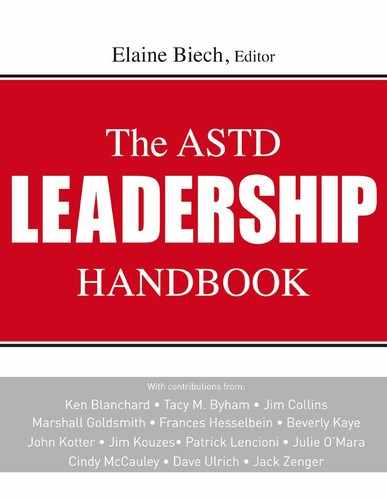 Appendix
Appendix
List and Descriptions of the Tools on the Website
Contributors to The ASTD Leadership Handbook provided tools to help you implement the leadership concepts you read about in the book. The tools are available for downloading at a companion website: www.astd.org/LeadershipHandbook. As long as you maintain the copyright information and the “used with permission” designation on the tool, you will be able to use it for your daily work.
Tool 2-1. The Five Practices and 10 Commitments of Leadership
James M. Kouzes and Barry Z. Posner
A list of 10 leadership commitments associated with the five practices of leadership.
Tool 3-1. Is Your Team Dysfunctional?
Patrick M. Lencioni
A straightforward diagnostic tool to help you evaluate your team’s susceptibility to the five dysfunctions.
Tool 4-1. Strategic Planning Analysis Questionnaire
Leonard D. Goodstein
A questionnaire intended to help understand the role of strategic planning in an organization.
Tool 5-1. Checklist of Poor Personal Communication
Dianna Booher
An individual checklist of symptoms of ineffective communication.
Tool 6-1. Influence Scenario Exercise
Gary Yukl
An exercise designed to help you think about effective ways to use proactive influence tactics with subordinates and peers.
Tool 7-1. John Kotter’s Eight-Stage Process
John Kotter
An eight-step process to ensure an orderly change that considers all steps in the change process.
Tool 8-1. Checklist for Managing Talent
Kevin Oakes and Holly Tompson
A checklist to compare your organization’s practices with the best practices of leading talent management companies.
Tool 8-2. Checklist of Common Talent Management and Financial Measurements
Kevin Oakes and Holly Tompson
A list of common measures that companies use to analyze their talent management practices.
Tool 9-1. The Virtuous Cycle of Attributes and Results
Dave Ulrich and Norm Smallwood
A chart for comparing various leaders’ perspectives.
Tool 10-1. Who’s the Jerk at Work?
Beverly Kaye and Sharon Jordan-Evans
A self-assessment for measuring your negative leadership behavior.
Tool 11-1. Decreasing Rank Orders of Learning Activities by Leader Level
Tacy M. Byham and William C. Byham
A table for considering the type of training that is most effective for different levels of supervisors.
Tool 12-1. Competency Engagement Checklist
Mark David Jones
A checklist for integrating leadership competencies into your organization’s operation for best-in-industry results.
Tool 13-1. Checklist for Avoiding Common Problems with Using 360-Degree Feedback
Craig Chappelow
A checklist to help your organization avoid common problems associated with 360-degree feedback assessments.
Tool 14-1. Decision Tool for Identifying Ways in Which Leaders Can Serve as Mentors and Teachers
Edward Betof
A checklist to help guide your thinking about the best ways that leaders can serve as mentors and teachers in your organization.
Tool 15-1. Developmental Assignment Plan Template
Ellen Van Velsor
A planning sheet to help map out a strategy for development opportunities.
Tool 15-2. Questions to Ask to Facilitate Learning from a Developmental Assignment
Ellen Van Velsor
A list of questions to assess personal competencies and reveal potential learning.
Tool 15-3. Enhancing Learning on the Job
Ellen Van Velsor
A checklist to determine how best to enhance individual learning in organizations.
Tool 16-1. Sample Minisurvey
Marshall Goldsmith
A sample minisurvey to be used as a guide for creating your own questions for coaching leaders.
Tool 18-1. What Inspiring Leaders Do Differently
Jack Zenger, Joe Folkman, and Scott Edinger
A list of the 10 behaviors that set inspiring and motivating leaders apart from the rest.
Tool 19-1. Leaders’ Personal Beliefs
Bill George
A list of thought-provoking questions to explore your own personal beliefs or those of other leaders.
Tool 20-1. Trust Index
Priscilla Nelson and Ed Cohen
A tool to self-assess leadership traits.
Tool 21-1. The Ethics Check
Ken Blanchard
A checklist to test the ethics of decision making.
Tool 22-1. Trends Shaping Future Leadership Attributes
Karie Willyerd and Jeanne Meister
A diagnostic tool to help you align future business conditions with leadership skills and competencies.
Tool 23-1. Checklist for Avoiding Leader Derailment
William A. Gentry
A checklist to identify steps to avoid leader derailment.
Tool 25-1. Nine Steps to Becoming a Globally Savvy Leader
Stephen H. Rhinesmith
A step-by-step process for becoming a globally savvy leader.
Tool 26-1. Clarifying Your Goals for Development: Tool for Leaders
Marian N. Ruderman
A way to assess which of the five themes that affect the development of women are most prevalent.
Tool 27-1. Guidelines for Positive Feedback
Joanne G. Sujansky
A set of four guidelines for providing positive feedback that works.
Tool 27-2. Cross-Generational Model for Giving Corrective Feedback
Joanne G. Sujansky
A model for providing results-oriented and constructive feedback.
Tool 28-1. Diversity Paradigm Tool
Kay Iwata, Juan T. Lopez, and Julie O’Mara
A self-assessment tool to gain insight into personal diversity attitudes to increase your diversity competence.
Tool 29-1. Tree of Life
Lyndon Rego, Steadman D. Harrison III, and David G. Altman
A self-empowerment exercise to help individuals or groups explore how they can achieve their desired future using their skills and resources.
Tool 30-1. 10 Diagnostic Questions for a Successful Immersion Program
Lawrena Colombo and John Verderese
Ten diagnostic questions that reveal the critical aspects of developing a successful leadership immersion program.
Tool 31-1. Essentials for Good Leadership
John Lockard
A checklist of essential leadership qualities for any organization.
Tool 32-2. Political Savvy Skills for Effective Leadership in the Federal Government
Will Brown
A list to help define four key behaviors that ensure mid- to upper-level leaders are effective in the federal government, or any organization where political savvy is required.
Tool 33-3. Cultural, Philosophical, and Ideological Influences on Chinese CEOs’ Thinking
Cheng Zhu
A chart for comparing the philosophy and ideology of major Chinese thought systems.
